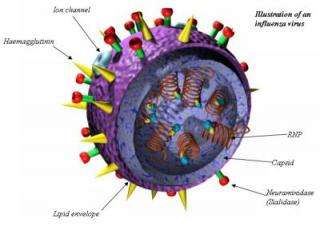FSU's Magnet Lab Researchers Deciphering Flu Virus

As the Northern Hemisphere braces for another flu season, researchers at Florida State University's National High Magnetic Field Laboratory are making strides toward better understanding the mechanics of the virus that causes it - a virus that kills between one-quarter and one-half million people each year.
Tim Cross, director of the lab's Nuclear Magnetic Resonance (NMR) program, and collaborators from Brigham Young University are trying to understand the minute parts of the highly virulent Influenza Type A virus. To do that, they are using all of the magnet lab's NMR resources, including its 15-ton, 900-megahertz magnet, to produce a detailed picture of the virus's skin.
"Using the magnet helps us build a blueprint for a virus's mechanics of survival," said Cross, who also is a professor of chemistry and biochemistry at FSU. "The more detailed the blueprint, the better our chances of developing drugs capable of destroying it."
The only magnet of its kind in the world, the "900" is critical to the project's process. Otherwise, an image this complicated would be impossible to obtain.
Cross and David Busath, a biophysicist at Brigham Young University, recently discovered key components of the protein holes, or "channels," in the influenza viral skin. These components lead to unique chemical interactions that are thought to be important clues for understanding how the channels regulate whether the virus can distribute its genes into host cells and reproduce or not. The researchers' findings were published recently in the Proceedings of the National Academy of Sciences.
"This is a viral structure we haven't seen before," Busath said. "And yet,
through these tiny little doors, acids must come in and DNA must go out if the virus is to survive. The idea is to block the door to prevent the normal function required for the virus to replicate."
Once researchers understand how these channels are selective for acid, they can use that knowledge to fashion novel drugs capable of more effectively killing the virus.
The work is funded by a five-year, multimillion-dollar grant from the National Institutes of Health. Other authors on the Proceedings of the National Academy of Sciences paper are Jun Hu, Riqiang Fu, Katsuyuki Nishimura, Li Zhang and Huan-Xiang Zhou, all of FSU, and Viksita Vijayvergiya, a former postdoctoral fellow at BYU.
Source: Florida State University





















